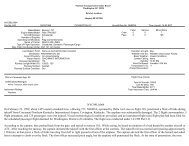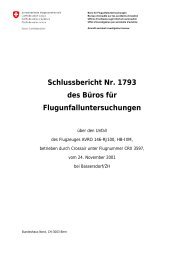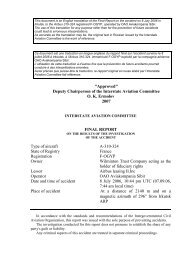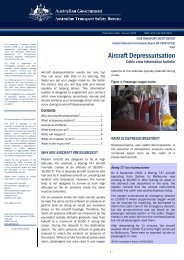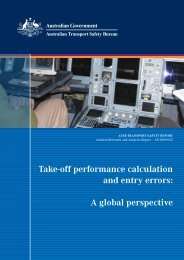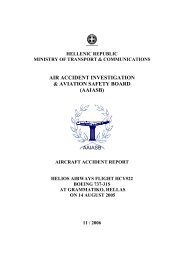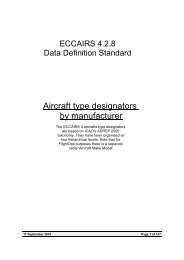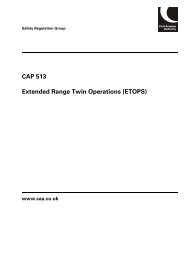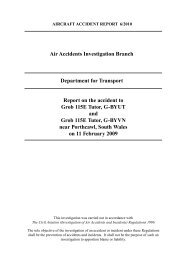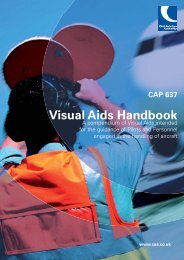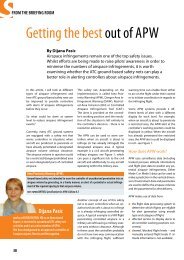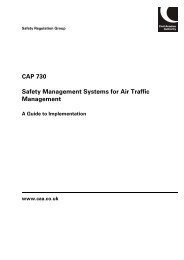CAP 772 - Birdstrike Risk Management for Aerodromes - SKYbrary
CAP 772 - Birdstrike Risk Management for Aerodromes - SKYbrary
CAP 772 - Birdstrike Risk Management for Aerodromes - SKYbrary
You also want an ePaper? Increase the reach of your titles
YUMPU automatically turns print PDFs into web optimized ePapers that Google loves.
<strong>CAP</strong> <strong>772</strong> <strong>Birdstrike</strong> <strong>Risk</strong> <strong>Management</strong> <strong>for</strong> <strong>Aerodromes</strong><br />
3.2.13.3 Bird scaring techniques using visible lasers are being developed. Although claims are<br />
made of their effectiveness, the use of lasers on an aerodrome is subject to<br />
requirements specified in ICAO Annex 14 Volume 1 and <strong>CAP</strong> 736, Guide <strong>for</strong> the<br />
Operation of Lasers, Searchlights and Fireworks in UK Airspace. Aerodrome operators<br />
considering the use of lasers <strong>for</strong> bird control purposes should consult the CAA prior<br />
to their operational use.<br />
3.2.13.4 All the above scarers should be evaluated <strong>for</strong> their effectiveness and used accordingly.<br />
Some may cease to be effective after a short time because of habituation.<br />
3.3 Lethal Methods<br />
3.3.1 There are several reasons <strong>for</strong> resorting to lethal control methods:<br />
a) to reduce overall numbers and thus to decrease the problem;<br />
b) <strong>for</strong> the deterrent effect it has on the surviving birds and to enhance the effect of<br />
other control techniques; and<br />
c) to remove individual birds which do not depart in response to scaring action, either<br />
because of sickness or disability, or because of aberrant behaviour.<br />
3.3.2 If there is no other satisfactory course of action <strong>for</strong> preserving air safety, shooting<br />
birds is an effective means of control. Special legal provisions exist to license the<br />
shooting of certain birds on aerodromes, subject to specified conditions. Trapping<br />
requires specialist knowledge and expertise, and the use of stupefying baits is illegal<br />
in the UK.<br />
3.3.3 During the breeding season, local birds are vulnerable and accessible to lethal control<br />
methods because they must return regularly to nest sites, and it is normally only<br />
necessary to kill one member of a pair. Thus, the population may be reduced and<br />
production of replacements prevented. However, the shooting of the most populous<br />
birds, such as Gulls, Lapwings and Starlings, with the intention of reducing numbers,<br />
is not usually effective, even on a temporary basis. Harassment is usually sufficient<br />
to prevent Lapwing colonies from becoming established. However, <strong>for</strong> some species,<br />
established breeders can only be removed by shooting. Removing eggs is less<br />
effective because Lapwings and some other waders will nest again. However, it may<br />
be possible to reduce numbers by taking action to prevent eggs hatching, by either<br />
pricking or oiling the eggs. The aim of this is to make the adult birds believe that the<br />
eggs will hatch and thus they will remain with the nest. When it is time <strong>for</strong> the eggs<br />
to hatch it is usually too late in the breeding cycle <strong>for</strong> the adult pair to produce new<br />
eggs.<br />
3.3.4 Most shooting is carried out on an aerodrome as a last resort against intractable flocks<br />
to deal with an immediate problem, but shooting can also be integrated into a control<br />
strategy to rein<strong>for</strong>ce scaring action. If scaring is followed by an actual stressful event<br />
such as shooting, birds learn to avoid the scarer more strongly. The effect may be<br />
sustained even if shooting is only occasionally added because the birds may simply<br />
react to the scaring signal alone and depart quickly.<br />
3.3.5 Non-lethal control methods are limited and only partially successful on Pigeons and it<br />
may be prudent to rein<strong>for</strong>ce them with live shooting on aerodromes where Pigeons<br />
are numerous. Wood pigeons, especially, are commonly shot in fields to protect crops<br />
and, thus, are particularly responsive to shooting. However, this is only a partial and<br />
short-term substitute <strong>for</strong> control of the birds' food supply.<br />
3.3.6 Successful trapping may require special skills and experience and the law may limit<br />
some actions; there<strong>for</strong>e, specialist advice should be sought be<strong>for</strong>e traps are<br />
introduced onto an aerodrome.<br />
March 2007<br />
Chapter 4 Page 13





